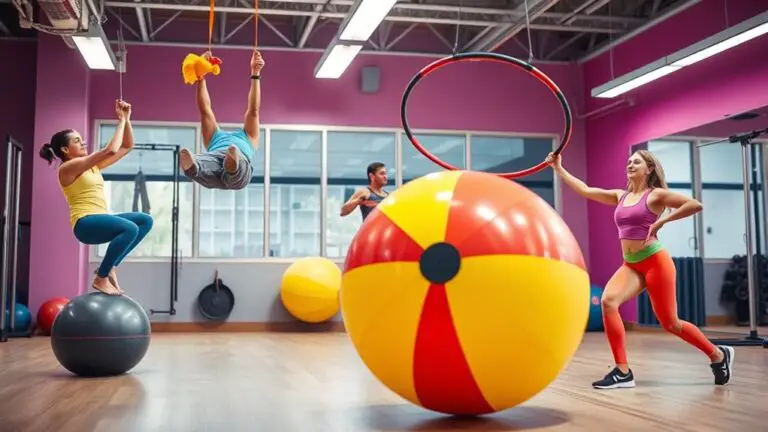How Lifting Weights Helps in Weight Loss

Lifting weights helps you lose weight by building lean muscle mass, which boosts your metabolism. With more muscle, your body burns more calories, even at rest. Plus, the energy you expend during workouts and the afterburn effect mean you’ll continue burning calories long after you’ve finished lifting. Combining strength training with cardio provides ideal results for weight loss and overall health. There’s much more to discover about how weightlifting can transform your fitness journey.
Understanding the Science Behind Weight Loss

When you think about weight loss, you might focus solely on diet, but understanding the science behind it reveals a more complex picture. Achieving a caloric deficit—burning more calories than you consume—is fundamental for weight loss, but it’s not the only factor at play. Hormonal balance plays an essential role in how your body processes food and stores fat. Hormones like insulin and cortisol can influence your appetite and metabolism, making it important to maintain a healthy balance.
When you eat well and exercise, you’re not just cutting calories; you’re also supporting your hormonal health. Incorporating strength training can help improve your body’s hormonal responses, making your weight loss journey safer and more effective. Remember, it’s not just about losing weight but doing it in a way that promotes overall health and well-being. Understanding these elements can lead to more sustainable and satisfying results.
The Role of Muscle Mass in Metabolism
Muscle mass plays an essential role in boosting your metabolism, as it requires more energy to maintain compared to fat. When you increase your muscle mass through weightlifting, you enhance muscle metabolism, which directly impacts your metabolic rate. This means your body burns more calories at rest, making weight management easier and more effective.
Having a higher metabolic rate not only helps with weight loss but also supports overall health. It can lead to better energy levels, improved mood, and increased strength. Additionally, maintaining muscle mass as you age can prevent metabolic decline, helping you stay fit and active.
Incorporating resistance training into your fitness routine is a safe and effective way to build muscle. Just remember to start with appropriate weights and focus on proper form to reduce the risk of injury. By doing so, you’ll reap the benefits of enhanced metabolism and improved overall well-being.
How Weightlifting Burns Calories

Building muscle is just one part of the equation; weightlifting also plays a significant role in burning calories. When you lift weights, your body uses energy, which contributes to a caloric deficit—an essential factor in weight loss. Even after your workout, your body continues to burn calories during muscle recovery, a process known as excess post-exercise oxygen consumption (EPOC). This means you’re still reaping the benefits long after you’ve finished lifting.
It’s vital to approach weightlifting safely, especially if you’re new to it. Start with lighter weights to guarantee proper form, reducing the risk of injury. Gradually increase the intensity to challenge yourself while allowing adequate time for muscle recovery. By incorporating weightlifting into your routine, you not only enhance your strength but also create an efficient way to burn calories, supporting your weight loss journey effectively.
Building Lean Muscle for Long-Term Weight Loss
While many focus on immediate weight loss results, building lean muscle is crucial for sustainable, long-term success. When you lift weights, you not only burn calories but also enhance your body’s metabolism through muscle recovery. This process allows your muscles to repair and grow stronger, which is essential for achieving strength progression.
Incorporating resistance training into your routine helps you maintain a healthy weight over time. As you gain muscle, your resting metabolic rate increases, meaning you’ll burn more calories even when you’re not working out. This makes it easier to manage your weight in the long run.
To guarantee safety, listen to your body and allow adequate time for muscle recovery between workouts. Gradually increase the intensity of your workouts, focusing on proper form. By prioritizing muscle development, you’ll set yourself up for enduring weight loss success while feeling strong and healthy.
The Afterburn Effect: Continuing to Burn Calories Post-Workout

When you finish a weightlifting session, the benefits don’t stop there; your body continues to burn calories long after you’ve left the gym. This phenomenon is known as the afterburn effect or excess post-exercise oxygen consumption (EPOC). Your muscles require energy to recover and repair, resulting in increased calorie expenditure even while you’re resting.
Here’s a quick overview of the afterburn effect:
| Time Post-Workout | Calorie Burn Rate | Total Calories Burned |
|---|---|---|
| 0-30 Minutes | Low | 50 |
| 30-60 Minutes | Moderate | 100 |
| 1-2 Hours | High | 200 |
| 2-24 Hours | Sustained | 300 |
| 24+ Hours | Minimal | 50 |
Combining Cardio and Strength Training for Optimal Results
Combining cardio and strength training can greatly enhance your weight loss efforts, as each type of exercise complements the other. By integrating both, you can enjoy a range of benefits that elevate your fitness journey.
Combining cardio and strength training enhances weight loss, as each complements the other for a more effective fitness journey.
- Maximize cardio benefits for fat burning.
- Achieve strength synergy to build lean muscle.
- Adjust workout intensity for varied challenges.
- Focus on recovery significance to prevent injury.
Incorporating exercise variations keeps workouts engaging and effective. Aim for a balanced training frequency that allows your body to adapt and grow stronger while prioritizing recovery. Nutrition pairing is also key; fuel your body with the right nutrients to support your efforts. This holistic approach guarantees your fitness progression remains steady and sustainable, helping you reach your weight loss goals safely. Remember, consistency is vital, so find a routine that works for you and stick with it! Additionally, it’s important to track personal benchmarks over time to assess your progress and ensure that your workouts are effective.
Creating a Balanced Workout Routine
To create a balanced workout routine, you need to contemplate both your fitness goals and the types of exercises that will help you achieve them. Incorporating strength training is essential, as it builds muscle and boosts metabolism. Aim for a consistent workout frequency, ideally 3-5 times a week, mixing cardio and strength exercises for optimal outcomes.
Ensure you include exercise variety to keep things engaging and to work different muscle groups, reducing the risk of injury. Remember, recovery is just as important; give your body time to heal and adapt.
Don’t forget about nutrition balance; fueling your body correctly supports your workouts and overall health. Additionally, integrating activities like skipping rope can improve cardiovascular fitness and enhance overall workout effectiveness. Set realistic goals to track your fitness progression and maintain personal motivation. By focusing on these elements, you’ll develop a thorough routine that aligns with your weight loss journey while prioritizing safety and well-being.
Overcoming Common Myths About Weightlifting
You might have heard a lot of misconceptions about weightlifting, especially when it comes to building muscle mass or whether it’s suitable for women. Many people debate the effectiveness of cardio versus weightlifting, but understanding the facts can help you make informed choices. Let’s clear up these myths so you can focus on what’s really beneficial for your weight loss journey.
Weightlifting Builds Muscle Mass
Weightlifting often evokes misconceptions, particularly the idea that it exclusively builds bulky muscle. In reality, weightlifting can help you achieve a toned physique while enhancing your overall strength. Here are some key points to reflect on:
- It promotes muscle recovery, allowing your body to heal and grow stronger.
- Engaging in consistent weightlifting can lead to significant strength progression over time.
- Increased muscle mass boosts your metabolism, aiding in weight loss.
- It enhances your functional fitness, making daily activities easier.
Women and Weightlifting Myths
The world of fitness is often clouded by myths, especially when it comes to women and weightlifting. Many believe that lifting weights will make you bulky or that it’s not safe. In reality, embracing weightlifting can enhance women’s strength and provide numerous lifting benefits. Here’s a quick look at some common myths:
| Myth | Truth |
|---|---|
| Lifting makes you bulky | Weightlifting helps tone and sculpt muscles |
| It’s unsafe for women | Proper technique guarantees safety and effectiveness |
| Only cardio aids weight loss | Weightlifting boosts metabolism and burns fat |
Cardio vs. Weightlifting Debate
While many people believe cardio is the only effective way to lose weight, incorporating weightlifting can considerably enhance your fitness journey. Weightlifting isn’t just for bodybuilders; it offers unique advantages that complement cardio efficiency.
- Boosts metabolism: Muscle burns more calories at rest.
- Increases strength: Everyday tasks become easier.
- Enhances body composition: You’ll burn fat while building muscle.
- Improves bone health: Stronger bones reduce injury risks.
Don’t let myths hold you back. Weightlifting benefits everyone, including beginners and those worried about injury. By balancing both cardio and weightlifting, you can create a well-rounded routine that promotes sustainable weight loss and overall health. Prioritize safety, and consult with a trainer if you’re unsure about starting a weightlifting regimen.
Success Stories: Real-Life Transformations Through Weightlifting
You might be surprised by the incredible transformations that come from lifting weights. Many people have shared inspiring journeys where they not only changed their bodies but also gained mental strength along the way. Let’s explore these real-life success stories that highlight the power of weightlifting in weight loss.
Inspiring Personal Journeys
How does lifting weights transform not just bodies, but lives? You might be surprised by the power of personal transformations that come from weightlifting. Many people start their journeys seeking a healthier lifestyle and discover so much more. Here are some motivational stories that inspire:
- Improved mental health and confidence
- Building a supportive community
- Overcoming physical limitations
- Achieving long-term fitness goals
Each story highlights the importance of safety and gradual progress. As you lift weights, you’re not only reshaping your body but also cultivating resilience and determination. Remember, every small victory counts. Your journey could inspire others, proving that with dedication and the right mindset, significant changes are possible. Embrace the process, and let your transformation begin!
Transformative Body Changes
When you commit to lifting weights, the physical changes you experience can be nothing short of remarkable. Many have transformed their body composition, shedding excess fat while building lean muscle. These success stories often highlight how consistent weightlifting leads to a more toned and defined physique. You might notice your clothes fitting better, as your body shape shifts in response to your hard work and dedication. With a focus on safety, it’s crucial to start with manageable weights and prioritize proper form to prevent injury. As you progress, you’ll likely find that your confidence grows alongside your physical transformation. Embracing this journey not only enhances your appearance but also contributes to your overall health and well-being.
Mental Strength Gains
Strength isn’t just about the muscles you build; it’s also a profound mental journey that weightlifting fosters. As you lift weights, you’re not just transforming your body; you’re developing mental resilience and discovering a newfound confidence boost.
- Overcoming challenges in the gym translates to everyday life.
- Each rep builds not just strength, but determination.
- You’ll learn to push through discomfort, enhancing your mental toughness.
- Celebrating small victories reinforces your self-belief.
Many have shared how weightlifting helped them conquer fears and anxieties, proving that the gym isn’t just a place for physical growth, but a sanctuary for mental fortitude. Embrace this journey, and you’ll find that the strength you gain extends far beyond the weights you lift.
Frequently Asked Questions
Can Beginners Start Weightlifting Without Prior Experience?
Absolutely, you can start weightlifting as a beginner! It’s crucial to focus on beginner techniques to guarantee safety and proper form. Start with lighter weights and gradually increase as you become more comfortable. The benefits of weightlifting are numerous; it builds strength, improves endurance, and boosts metabolism. Just remember to listen to your body and consider seeking guidance from a trainer to help you establish a solid foundation. You’ve got this!
How Often Should I Lift Weights for Weight Loss?
When it comes to weightlifting frequency, aim for about two to three times a week. This allows your muscles time to recover while still getting the benefits of strength training. Make sure you’re focusing on proper form to avoid injuries. Start with lighter weights and gradually increase as you gain confidence and strength. Always listen to your body; if you feel overly fatigued, don’t hesitate to take a rest day.
Do I Need Special Equipment for Weightlifting at Home?
You don’t necessarily need special equipment for weightlifting at home. While dumbbell alternatives like water bottles or resistance bands can be great, you can also focus on bodyweight exercises, such as push-ups and squats. These options can effectively build strength without the risk of injury that sometimes comes with using heavy weights. Just make sure you maintain proper form and listen to your body to stay safe while working out at home.
Can Weightlifting Help Improve My Overall Fitness Level?
Absolutely, weightlifting can greatly improve your overall fitness level. By engaging in strength training, you’ll not only build muscle but also enhance your endurance and flexibility. These fitness benefits contribute to better performance in daily activities and reduce the risk of injury. Remember to start with lighter weights and focus on proper form to guarantee safety. Gradually increasing intensity will help you progress while minimizing the chances of strain or injury.
What Should I Eat Before and After Weightlifting Sessions?
Before you lift, load up on low-fat, lively pre-workout snacks like bananas or yogurt for energy. After your session, savor satisfying post-workout meals rich in protein, like grilled chicken or quinoa, to aid recovery. Don’t forget to hydrate! Keeping your body fueled with proper nutrition is key to staying safe and maximizing your workouts. So, remember, what you eat matters just as much as those weights you’re lifting!





